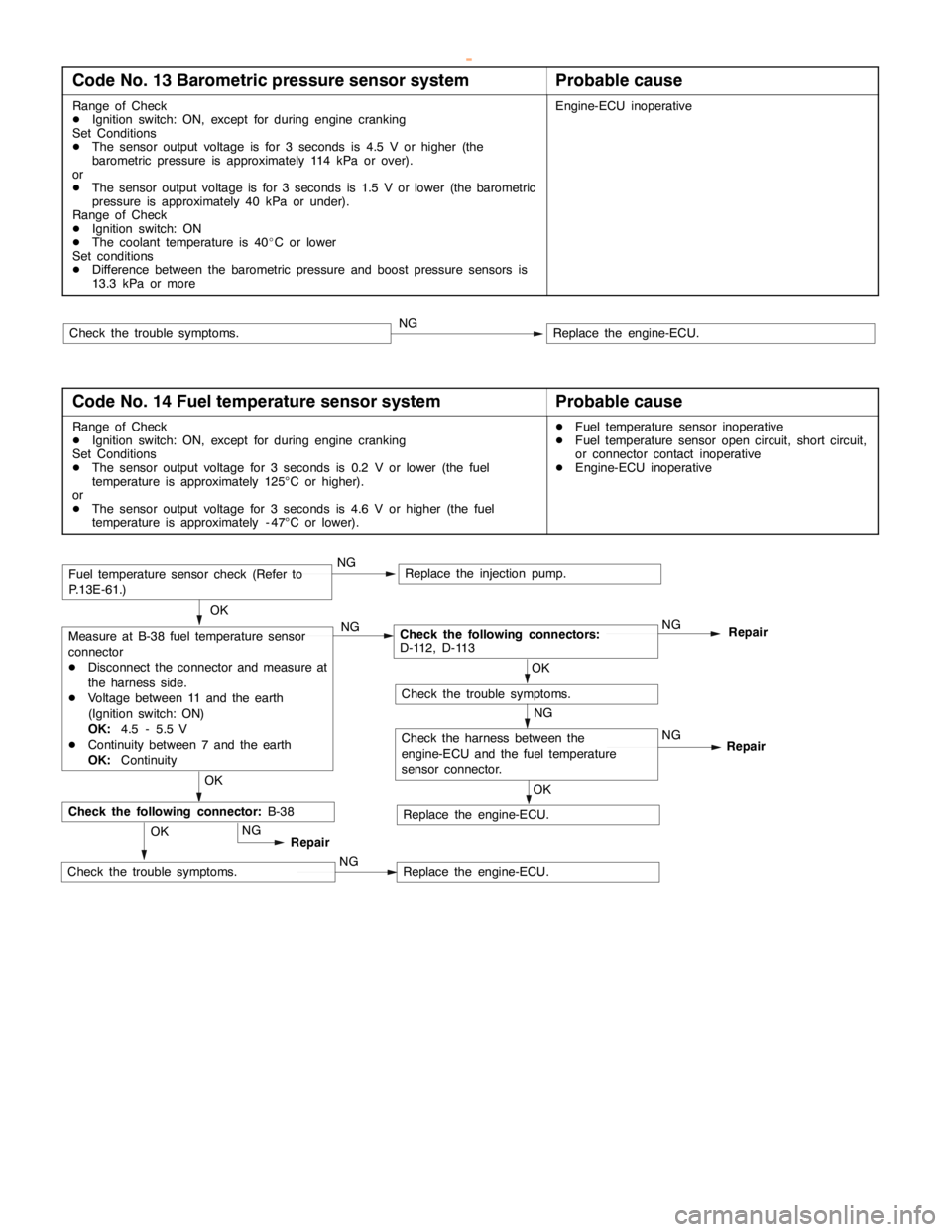2000 MITSUBISHI MONTERO coolant
[x] Cancel search: coolantPage 557 of 1839

DIESEL FUEL <4M4> -General/Service Specifications/Troubleshooting13C-2
GENERAL
OUTLINE OF CHANGES
Some service procedures have been established as the following changes have been made due to the
compliance with the Emission Regulation StepIII.
DThe intake manifold cover and injection pump cover have been reshaped.
DThe throttle body assembly has been changed.
DThe EGR valve assembly has been changed.
SERVICE SPECIFICATIONS
ItemStandard value
Throttle body assembly resistanceΩat - 10 - 50_C12 - 20
at 50 - 100_C12 - 23
TROUBLESHOOTING
FAIL-SAFE, BACKUP FUNCTIONS
When abnormalities in the major sensors are detected by diagnosis functions, pre-set control logic operates
to maintain a safe driving condition for the vehicle.
Diagnosis itemControl features in malfunction
Accelerator pedal position sensorDAccelerator pedal released (idle switch ON)
Acceleration opening degree = 0 %
DAccelerator pedal applied (idle switch OFF)
Engine controlled at low speed
Acceleration opening degree = 40 %
DVoid cruise control
Idle switchDVoid idling speed control
DVoid cruise control
Engine speed sensorDEngine controlled at low speed
DVoid cruise control
Boost air temperature sensorMaintain the intake air temperature at 50_C
Vehicle speed sensorDVoid idling speed control
DVoid cruise control
DWith accelerator pedal released (when idle switch is on)
Accelerator opening angle = 0 %
DWith accelerator pedal depressed (when idle switch is off)
Accelerator opening angle = Fixed at 40 % (M/T), 28 % (A/T)
Engine coolant temperature sensorMaintain the engine coolant temperature at 80_C (engine running), 0_C
(engine stopped or just started)
Control sleeve position sensorDWith accelerator pedal released (when idle switch is on)
Engine speed = 800 r/min
DWith accelerator pedal depressed (when idle switch is off)
Engine speed = 2,000 r/min
DVoid cruise control
Timer piston position sensorDOpen control by means of engine speed
DVoid cruise control
Barometric pressure sensor (ECU built-in)Keep the barometric pressure at 101 kPa
www.WorkshopManuals.co.uk
Purchased from www.WorkshopManuals.co.uk
Page 611 of 1839

13E-1
DIESEL FUEL
<4D5-STEPIII
>
CONTENTS
GENERAL 2.................................
Outline of Change 2............................
GENERAL INFORMATION 2...................
SERVICE SPECIFICATIONS 4.................
SEALANT 4..................................
SPECIAL TOOLS 5...........................
TROUBLESHOOTING 6.......................
ON-VEHICLE SERVICE 55....................
Injection Nozzle Check and Adjustment 55.........
Injection Timing Check and Adjustment 55.........
Idle Speed Check and Adjustment 55.............
Accelerator Pedal Position Sensor (APS)
Adjustment 56.................................
Control Relay Continuity Check 57................
Accelerator Pedal Position Sensor (APS)
Check 57......................................Idle Switch Check 58............................
Boost Air Temperature Sensor (Intake Air
Temperature Sensor) Check 58..................
Engine Coolant Temperature Sensor Check 59.....
Evacuation of Water from Fuel Filter 59............
Fuel Filter Cartridge Replacement 60..............
Evacuation of Air from Fuel Line 60...............
EGR Valve Position Sensor Check 60.............
Fuel Injection Pump Check 61....................
Throttle Solenoid Valve Check 62.................
Throttle Actuator Check 63......................
Variable Geometry Solenoid Valve Check 63.......
EGR Control Solenoid Valve Check 63............
FUEL INJECTION NOZZLE 64.................
FUEL INJECTION PUMP 64...................
CRANKSHAFT POSITION SENSOR 66.........
ENGINE-ECU 66.............................
www.WorkshopManuals.co.uk
Purchased from www.WorkshopManuals.co.uk
Page 612 of 1839

DIESEL FUEL <4D5-stepIII>-General/General Information13E-2
GENERAL
OUTLINE OF CHANGE
An electronically-controlled injection pump has been added in order to comply with Regulation STEP
III. Due to this, the following service procedures have been added.
GENERAL INFORMATION
The electronically-controlled fuel injection system consists of sensors which detect the condition of the
diesel engine, an engine-ECU which controls the system based on signals from these sensors, and actuators
which operate according to control commands from the engine-ECU.
The engine-ECU carries out operations such as fuel injection rate control, fuel injection timing control
and idle up control. In addition, the engine-ECU is equipped with several self-diagnosis functions which
make troubleshooting easier in the event that a problem develops.
FUEL INJECTION RATE CONTROL
The fuel injection completion timing is controlled by means of a solenoid-type spill valve to ensure that
the optimum amount of fuel is supplied to the engine in accordance with gradual changes in the engine
running condition.
Before fuel injection starts, the solenoid-type spill valve is on (energized), so that the valve is closed.
As the plunger turns and rises, fuel is sent out under pressure, and when the fuel flow rate reaches
the target value for fuel injection, the solenoid-type spill valve turns off. When the solenoid-type spill
valve turns off, the fuel under high pressure inside the plunger is leaked out into the pump chamber
and fuel injection is completed.
FUEL INJECTION TIMING CONTROL
The position of the injection pump timer piston is controlled so that fuel injection is carried out at the
optimum timing in accordance with the engine running condition.
The timer piston position is determined by duty control of the timing control solenoid valve which is located
in the line between the high-pressure chamber and the low-pressure chamber of the timer piston.
The fuel injection timing is advanced by increasing the control duty of the timing control solenoid valve.
IDLE SPEED CONTROL
Controlling the fuel injection rate in accordance with the engine running condition maintains the idle speed
at the optimum condition.
SELF-DIAGNOSIS FUNCTION
DWhen an abnormality is detected in any of the sensors or actuators, the engine warning lamp illuminates
to warn the driver.
DWhen an abnormality is detected in any of the sensors or actuators, a diagnosis code number
corresponding to the problem which occurred is output.
DThe RAM data relating to the sensors and actuators which is stored in the engine-ECU can be read
using the MUT-II. In addition, the actuators can be force-driven under certain conditions.
OTHER CONTROL FUNCTIONS
1. Power Supply Control
When the ignition switch is turned to ON, the relay turns on and power is supplied to components
such as the timing control solenoid valve.
2. Intake Air Throttle Control
When the engine-ECU detects an abnormality in any of the sensors or actuators, the throttle valve
is half opened to restrict the amount of intake air in order to prevent the vehicle from running away.
3. A/C Relay Control
Turns the compressor clutch of the A/C ON and OFF
4. Condenser Fan Motor Relay Control
Controls the condenser fan motor relay based on the A/C switch, engine coolant temperature and
vehicle speed input signals.
5. Glow Control
Refer to GROUP 16.
6. EGR Control
Refer to GROUP 17.
www.WorkshopManuals.co.uk
Purchased from www.WorkshopManuals.co.uk
Page 614 of 1839

DIESEL FUEL <4D5-stepIII>-Service Specifications/Sealant13E-4
SERVICE SPECIFICATIONS
ItemStandard value
Fuel injection initial pressure kPa14,710 - 15,490
Accelerator pedal position sensor reference voltage V0.985 - 1.085
Accelerator pedal position sensor resistance kΩ3.5 - 6.5
Boost air temperature sensor (Intake air temperature
)itkΩ
When the temperature is 20_C2.3 - 3.0p(p
sensor) resistance kΩWhen the temperature is 80_C0.30 - 0.42
Engine coolant temperature sensor resistance kΩWhen the temperature is 20_C2.1 - 2.7gp
When the temperature is 80_C0.26 - 0.36
Fuel cut solenoid valve resistanceΩ6.8 - 9.2
Timing control valve resistanceΩ10.8 - 11.2
Timer piston position sensor resistanceΩConnector terminals No. 1 - No. 2160 - 168pp
Connector terminals No. 1 - No. 380 - 84
Connector terminals No. 2 - No. 380 - 84
Control sleeve position sensor resistanceΩConnector terminals No. 4 - No. 1211.2 - 12.4p
Connector terminals No. 4 - No. 85.6 - 6.2
Connector terminals No. 8 - No. 125.6 - 6.2
GE actuator (electronic governor) resistanceΩConnector terminals No. 6 - No. 100.64 - 0.72
Fuel temperature sensor resistance kΩConnector terminals No. 7 - No. 111.4 - 2.6
Pump speed sensor resistance kΩ1.36 - 1.84
Throttle solenoid valve resistanceΩ36 - 44
SEALANT
ItemSpecified sealant
Engine coolant temperature sensor3M Nut Locking Part No. 4171 or equivalent
www.WorkshopManuals.co.uk
Purchased from www.WorkshopManuals.co.uk
Page 617 of 1839

DIESEL FUEL <4D5-stepIII>-Troubleshooting13E-7
FAIL-SAFE, BACKUP FUNCTIONS
When abnormalities in the major sensors are detected by diagnosis functions, pre-set control logic operates
to maintain a safe driving condition for the vehicle.
Diagnosis itemControl features in malfunction
Accelerator pedal position sensorDAccelerator pedal released (idle switch ON)
Acceleration opening degree = 0 %
DAccelerator pedal applied (idle switch OFF)
Engine controlled at low speed
Acceleration opening degree = 30 % fixed
DVoid EGR control
Idle switchVoid idling speed control.
Engine speed sensorDEngine controlled at low speed
DVoid EGR control
DVoid variable geometry turbocharger control
Boost air temperature sensorDMaintain the intake air temperature at 50_C.
DVoid EGR control
Vehicle speed sensorDVoid idling speed control.
DVoid EGR control
Engine coolant temperature sensorDMaintain the engine coolant temperature at 80_C (However, the system
assumes the coolant temperature as 0_C).
DVoid EGR control
Control sleeve position sensorDEngine controlled at low speed
DVoid EGR control
DVoid variable geometry turbocharger control
Timer piston position sensorDInjection timing stabilizing control
DVoid EGR control
Barometric pressure sensor (ECU
built-in)DKeep the barometric pressure at 101 kPa.
DVoid EGR control
DVoid variable geometry turbocharger control
Fuel temperature sensorMaintain the fuel temperature at 40_C.
Boost pressure sensorDKeep the boost pressure as barometric pressure (101 kPa).
DVoid EGR control
DVoid variable geometry turbocharger control
Injection volume adjusting ROMVoid correction.
GE actuatorDEngine controlled at low speed
DVoid EGR control
DVoid variable geometry turbocharger control
Over boostDVoid variable geometry turbocharger control
DEngine controlled at low fuel injection
Timing control valveDInjection timing stabilizing control
DVoid EGR control
EGR valve position sensorVoid EGR control
Variable geometry control pressure
sensorDVoid EGR control
DVoid variable geometry turbocharger control
www.WorkshopManuals.co.uk
Purchased from www.WorkshopManuals.co.uk
Page 618 of 1839

DIESEL FUEL <4D5-stepIII>-Troubleshooting13E-8
INSPECTION CHART FOR DIAGNOSIS CODES
Code No.Diagnosis itemReference
page
11Accelerator pedal position sensor (main) system13E-9
12*Boost pressure sensor system13E-10
13Barometric pressure sensor (ECU built-in) system13E-11
14Fuel temperature sensor system13E-11
15Engine coolant temperature sensor system13E-12
16Boost air temperature sensor system13E-12
17Vehicle speed sensor system13E-13
18Pump speed sensor system13E-14
21Crank angle sensor system13E-15
23Idle switch (accelerator pedal position sensor built-in) system13E-16
25*Timer piston position sensor system13E-17
26*Control sleeve position sensor system13E-18
27Accelerator pedal position sensor (sub) system13E-19
41*Throttle solenoid valve system13E-20
43Timing control valve system13E-21
46Injection volume adjusting ROM system13E-22
48*GE actuator (in the middle of control sleeve position sensor inoperative) system13E-23
49*Over boost (variable geometry control pressure sensor system malfunction)13E-24
51EGR valve position sensor system13E-25
52Variable geometry control pressure sensor system13E-26
54Immobilizer system13E-27
Caution
If the above-mentioned diagnosis code number with the asterisks can be displayed along with another
code number in parentheses simultaneously, check the other code number before replacing the
engine-ECU.
12 (41, 49), 26 (48), 25 (43), 41 (12, 49), 48 (26), 49 (12, 41)
www.WorkshopManuals.co.uk
Purchased from www.WorkshopManuals.co.uk
Page 621 of 1839

DIESEL FUEL <4D5-stepIII>-Troubleshooting13E-11
Code No. 13 Barometric pressure sensor systemProbable cause
Range of Check
DIgnition switch: ON, except for during engine cranking
Set Conditions
DThe sensor output voltage is for 3 seconds is 4.5 V or higher (the
barometric pressure is approximately 114 kPa or over).
or
DThe sensor output voltage is for 3 seconds is 1.5 V or lower (the barometric
pressure is approximately 40 kPa or under).
Range of Check
DIgnition switch: ON
DThe coolant temperature is 40_C or lower
Set conditions
DDifference between the barometric pressure and boost pressure sensors is
13.3 kPa or moreEngine-ECU inoperative
Replace the engine-ECU.NGCheck the trouble symptoms.
Code No. 14 Fuel temperature sensor systemProbable cause
Range of Check
DIgnition switch: ON, except for during engine cranking
Set Conditions
DThe sensor output voltage for 3 seconds is 0.2 V or lower (the fuel
temperature is approximately 125°C or higher).
or
DThe sensor output voltage for 3 seconds is 4.6 V or higher (the fuel
temperature is approximately - 47°C or lower).DFuel temperature sensor inoperative
DFuel temperature sensor open circuit, short circuit,
or connector contact inoperative
DEngine-ECU inoperative
OK
Measure at B-38 fuel temperature sensor
connector
DDisconnect the connector and measure at
the harness side.
DVoltage between 11 and the earth
(Ignition switch: ON)
OK:4.5 - 5.5 V
DContinuity between 7 and the earth
OK:ContinuityNGCheck the following connectors:
D-112, D-113NG
Repair
OK
OK
Check the harness between the
engine-ECU and the fuel temperature
sensor connector.Repair
NG
Check the trouble symptoms.
Replace the engine-ECU.NG
Replace the engine-ECU.OKNG
Replace the injection pump.
OK
Repair
Check the following connector:B-38
NG
NGCheck the trouble symptoms.
Fuel temperature sensor check (Refer to
P.13E-61.)
www.WorkshopManuals.co.uk
Purchased from www.WorkshopManuals.co.uk
Page 622 of 1839

DIESEL FUEL <4D5-stepIII>-Troubleshooting13E-12
Code No. 15 Engine coolant temperature sensor systemProbable cause
Range of Check
DIgnition switch: ON, except for during engine cranking
Set Conditions
DThe sensor output voltage for 3 seconds is 4.9 V or higher (the coolant
temperature is approximately - 45_C or lower).
or
DThe sensor output voltage for 3 seconds is 0.2 V or lower (the coolant
temperature is approximately 140_C or higher).DEngine coolant temperature sensor inoperative
DEngine coolant temperature sensor open circuit,
short circuit, or connector contact inoperative
DEngine-ECU inoperative
OK
NGNG
Repair
OK
OKRepair
NGEngine coolant temperature sensor check
(Refer to P.13E-59.)
Replace the engine-ECU.NG
Replace the engine-ECU.OK NG
OK
Repair
Check the following connector:B-56
NGCheck the trouble symptoms.NG
Measure at B-56 engine coolant temperature
sensor connector
DDisconnect the connector and measure at
the harness side.
DVoltage between 1 and the earth
(Ignition switch: ON)
OK:4.1 - 4.9 V
DContinuity between 2 and the earth
OK:ContinuityCheck the following connectors:
D-112, D-113
Check the harness between the
engine-ECU and the engine coolant
temperature sensor connector.
Check the trouble symptoms. Replace
Code No. 16 Boost air temperature sensor (intake air
sensor) systemProbable cause
Range of Check
DIgnition switch: ON, except for during engine cranking
Set Conditions
DThe sensor output voltage for 3 seconds is 4.6 V or higher (the intake air
temperature is approximately - 45_C or lower).
or
DThe sensor output voltage for 3 seconds is 0.3 V or lower (the intake air
temperature is approximately 110_C or higher).DBoost air temperature sensor inoperative
DBoost air temperature sensor open circuit, short
circuit, or connector contact inoperative
DEngine-ECU inoperative
OK
Measure at B-49 boost air temperature
connector
DDisconnect the connector and measure at
the harness side.
DVoltage between 1 and the earth
(Ignition switch: ON)
OK:4.0 - 5.3 V
DContinuity between 2 and the earth
OK:ContinuityNGCheck the following connectors:
D-112, D-113NG
Repair
OK
OKRepair
NGBoost air temperature sensor check
(Refer to P.13E-58.)
Check the trouble symptoms.
Replace the engine-ECU.NG
Replace the engine-ECU.OK NG
OK
Repair
Check the following connector:B-49Replace
NGCheck the trouble symptoms.NG
Check the harness between the
engine-ECU and the boost air temperature
sensor connector.
www.WorkshopManuals.co.uk
Purchased from www.WorkshopManuals.co.uk